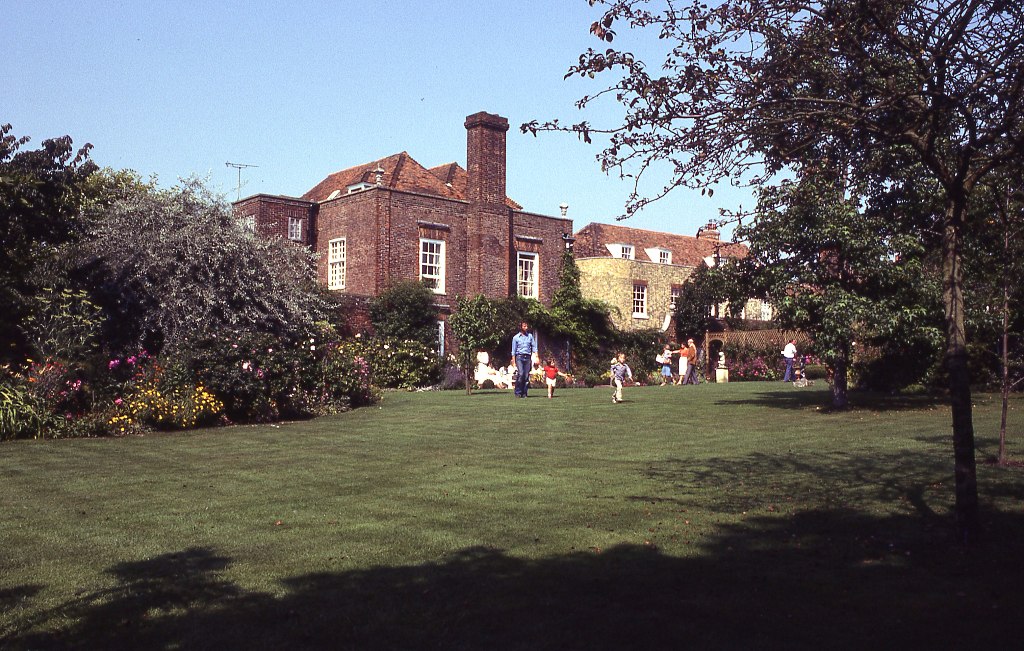The Haunted Tenants of Henry James

When Rumer Godden moved to Rye, it was because her house had burned down. Little Doucegrove, a converted farmhouse ringed by a vast expanse of woodland, caught fire when a pan of oil was left on the stove. According to Godden’s 1989 autobiography, A House With Four Rooms, the flames spared nothing but walls and drainpipes, leaving behind the ashes of a freshly planted rose garden.
Already in her sixties, the Sussex-born writer found herself having to start over. Her husband, the retired civil servant James Haynes-Dixon, suffered a breakdown when the flames engulfed their home—doctors warned them that he’d never plant another rosebush or take another drive. In response, Godden moved her family to the sleepy, saltwater town of Rye, some eight miles southeast of Little Doucegrove. There, cobbled walkways crisscrossed narrow greens, and no one even needed a car. Godden rented Lamb House, an elegant, brick-faced Georgian manse that came equipped with a plush rose garden. It had once belonged to Henry James.
By the time Godden arrived in 1968, the great Anglo-American novelist had been dead for over half a century, but the house was still very much his. When the aging couple moved in, they took over as the tenants of Lamb House, the way you might say “the phantom of the opera” or “the hunchback of Notre Dame.” Godden and her James might enjoy the place—her, writing in Henry’s Green Study; him, convalescing outside (contrary to the doctors’ pronouncements, he was motoring around the continent within a year)—but they were enclosed by Henry’s pale oak panels, warmed by Henry’s marbled hearths. They even lived their lives around the schedule imposed by the long-dead “Master,” as Godden and his other fans called him.
When they agreed to lease Lamb House from the National Trust, Godden and her husband signed on as more than a dead man’s spiritual tenants: they were stewards of his memory, perpetual guests in his home. In exchange for the right to lounge in the Master’s bedroom, they had to open the designated Henry James room and the garden to visitors twice a week. Besides that, they shepherded special tours—periodic groups of Jamesian scholars and literary pilgrims—around the Master’s old stomping grounds.
The house wasn’t kept in a time-capsule stasis after James’s death—by Godden’s time, many of his old possessions had been sold at auction, to be returned piecemeal by bibliophile donors in the years to come. Still, throughout Godden’s tenancy, the ghostly traces of James’s Lamb House seemed to reemerge from within the rooms in which she lived and worked, peeking out from beneath the veneer of the present. One year, four of her grandchildren came to stay, filling the long-childless Lamb House, for the first time in a century, with “piercing child voices [and] the scampering of feet.” Godden felt, behind their raucous vitality, a “strange sense of ‘presences’—two other children, silent, well-behaved.” These young phantoms seemed to be “watching,” she writes. “Soon I knew who they were, Miles and Flora. Our own children had brought them out of the Green Study where Henry James had conceived them. After our four had gone I had the feeling Miles and Flora were still there.”
Miles and Flora emerged from The Turn of the Screw, James’s Gothic masterwork. Based on a scary story he heard from Edward White Benson, the archbishop of Canterbury, this chillingly ambiguous novella kaleidoscopes from haunted house narrative to portrait of madness, depending on how it reflects back the reader’s own fears. The apple-cheeked Miles and Flora, ages ten and eight, frolic at the crux of the story’s ambiguity. With their “impersonal,” uncanny manners and their “extraordinary childish grace,” they’re either innocents endangered by a psychotic governess or the deceitful little allies of the damned. By the midpoint of James’s narrative, the siblings’ governess—mad or not—insists that “even while they pretend to be lost in their fairytale they’re steeped in their vision of the dead restored.”
By writing the fictional siblings into her account of her tenancy, Godden restores the dead James, at the height of his dark genius, to his old place in the study she came to occupy. But she also takes up Miles and Flora’s legacy of narrative ambiguity. Does she really believe her rental home was haunted by the phantasmic creations of its most famous occupant—haunted, that is, by a text instead of a ghost? Or is she playing, in her autobiography, with the shivering fancies of the Jamesians who visited her in Rye, fans who would have been thrilled to glimpse Miles and Flora as they strolled through her house?
It’s true that Godden was no skeptic when it came to encounters with the uncanny. Not only did she—like James—write ghost stories, but she consistently claimed to live them too. In A House With Four Rooms, she reports multiple instances of “poltergeist troubles” that caused cisterns and pipes to shatter in her presence. Even in Lamb House, these ghouls seemed to hound her: she blames them for the unexplained disappearance of a manuscript from the Green Study. Given James’s enduring presence in the house, then, it’s tempting to read these spectral book thieves as his partisans, affronted by the usurper at his desk.
If the ghosts who purloined her manuscript thought of her as an unworthy successor to James, Godden herself would not have disagreed—at least at first. In A House With Four Rooms, she concedes it was “awesome” to follow the Master to the Green Study, in the slightly shivery traditional sense of the word—“intimidating” and “daunting.” But as she immersed herself in life at his house, Godden’s longstanding admiration of James, the novelist, shaded into ambivalence towards Henry, the man. The biographies she devoured described him as “so kind and gentle, such good company,” but they were challenged by the living memory of his former valet, Burgess Noakes, a “tiny rubicund man” who stayed in Rye after James’s death.
Noakes shared memories that “showed another side of his master, though not realizing,” Godden acknowledged, “that they were denigrating” to his memory. The young valet, for example, was bullied by the Lamb House cook, James’s favored employee, while the great novelist turned a blind eye. Even more distastefully to Godden, James made Noakes take a rambunctious dachshund puppy to the vet and then “bring him back in a bag—dead.” For Godden, this story recontextualized a now-familiar feature of Lamb House’s grounds: a “dog cemetery with small plaques on the wall,” set in a corner of the garden. She found herself wondering how “Henry James could have borne to look at it.” Although distressed by his apparent callousness, Godden nevertheless “admired and lived with the novels” that earned the Master his fame. His multiplicity made him as hard to pin down as the fictive siblings who haunted his former study. Just as Miles and Flora were at once lovable orphans and demonic mouthpieces, Henry James was, to his tenant, both the kindly genius of the books and the stone-hearted master of living memory.
Perhaps this ambivalence made him more, not less, persistent a presence, as Lamb House became a place of dead dogs as well as literary phantoms. Regardless of whether The Turn of the Screw’s siblings actually played beside her as she wrote, it was clear that Godden felt haunted by the man whose desk she occupied, and whose worshipful fans she conducted around the house. Tellingly, she titled the Lamb House chapter of her book “Shades of Henry James.”
Godden wasn’t the only writer to settle in James’s house, living and working in the iconic novelist’s shadow, and perhaps among his ghosts. Over the years, Lamb House developed a reputation as the haunt of literary figures, both literal and figurative. That wasn’t due to Henry James alone—his direct successor as the resident of Lamb House, the novelist E.F. Benson, also contributed to the house’s mystique.
Fred, as his friends called him, occupied the Lamb House from 1918 until his death in 1940. He built his reputation primarily on acid-tongued comedies of manners. But like both James before and Godden after him, Benson wrote ghost stories, too. His penchant for horror was, it seems, something carried in the blood. It was his father, the archbishop of Canterbury, E.W. Benson, who told James the tale that would morph into The Turn of the Screw.
Benson’s tales of haunting may, like Godden’s, have also drawn on his personal experience. In his 1940 memoir, Final Edition, he records an encounter with a ghost in the Lamb House garden, a mysterious, black-garbed man. This apparition also appeared to the Rye vicar, who was walking with him in the garden after lunch. Clad in a “cape the right wing of which . . . . he threw across his chest,” the figure stepped quickly out of sight without showing either man his face. When Benson and the vicar tried to follow him, they saw only the garden, “basking in the sun and empty of any human presence.” Benson’s caped phantasm has no analogue in the Jamesian oeuvre. Unlike Godden, he never claimed to be visited by the phantasms from his predecessor’s mind. Perhaps that’s because he had no need for the fragmentary presences of James’s creations—he could fall back on memories of the creator himself.
Though he was twenty-four years younger than James, the two men knew each other well, and it was clear that Benson admired James greatly. When he drafted his first novel, Dodo, at the age of twenty-six, he mailed the manuscript—inked out by hand—to the older writer. Critics on both sides of the Atlantic found the cutting social satire a delight, but James, by then already the celebrated author of The Portrait of a Lady, did not. Final Edition, recounts his sending “two or three . . . brilliantly evasive letters about” his young friend’s draft before finally admitting he “did not find it as ‘ferociously literary’ as his taste demanded.”
The two writers might not have seen eye-to-eye on the relative merits of light, popular fare, but that didn’t stop their intergenerational friendship from flourishing. The first time Benson set foot in Lamb House, it was by James’s invitation—the older writer, already in his fifties, had just moved in. As his houseguest, Benson got the opportunity to see his friend’s creations come together, in a rush of voluminous sound, as he recalled in Final Edition:
When Henry James had withdrawn himself here for his morning’s work, none might disturb him, and as lunch time approached one sat in the garden by the steps waiting for him to emerge, and could hear his voice booming and pausing and booming again, as he moved up and down the book-lined room dictating the novel on which he was at work to his typist. The clacking of the keys of her machine formed a sort of castanet accompaniment.
“Here” refers to the detached Garden Room, where James ensconced himself to write in the summers. German bombs leveled it during World War II—coincidentally the year of Benson’s death. In three sepia-tinged photos held by the National Trust, we can see the aftermath of the Nazi air raid: splintered beams piled against the ashen face of Lamb House, bricks ringing the black maw of the broken ground. But older pictures, and a scale model, show the Garden Room as it was: a little house unto itself, with a rosy porthole set like a jewel in its crown, and an enormous bay window opening out into the street. It was here that James produced The Turn of the Screw, as well as the three mature novels that cemented his reputation as a major English novelist: The Wings of the Dove, The Ambassadors, and The Golden Bowl.
The Garden Room was never rebuilt. Godden never got to take the Master’s place there, the way she “followed” him to his wintry workstation in the Green Study. Benson, however, adopted it as his summer writing retreat. As he sat in James’s old seat, he no doubt recalled the sound of his old friend at work, filling the room with sinuous sentences blared out at an operatic volume. The Mapp and Lucia series, the wickedly funny novels he’s remembered for today, came into being within view of James’s great bay window.
Benson established his antiheroine, the busybody spinster Elizabeth Mapp, in a fictional version of Lamb House. Her brick-faced Georgian manse—set in a fictional town that mapped, acre for acre, onto the cobbled walkways of Rye—came complete with its own detached Garden Room, where she established herself like a parodic anti-James: not loudly bringing stories to life, but spying on her neighbors in silence. In this familiar setting, Benson stage-managed his newly conceived Miss Mapp into a confrontation with another character he’d already created, to some acclaim: the pretentious and domineering star of his 1920 novel, Queen Lucia. Loo-CHEE-ah, so pronounced, was the Italophile nickname of Mrs. Emmeline Lucas, the undisputed ruler of a neighboring town. But when her husband’s death prompts a change of scene, she finds herself in Mapp’s seaside village, facing something unexpected: a true rival for her social crown.
In the Mapp and Lucia novels, Benson tracks the game of social one-upmanship unfolding between the established spinster and the newcomer widow, deploying all the rapid-patter avidity of a tennis commentator. The focal point of their rivalry was his own house, fictionalized. Lucia originally encountered its “charming little panelled parlours” and “plain well-shaped rooms” as a widow seeking a change. She moved into the house for the first time as Mapp’s summer tenant. By the tail-end of the series, however, the property had changed hands, ping-ponging to Lucia in an odd stroke of financial fortune.
Benson’s series is no Turn of the Screw. Its world is soundtracked by tinkling laughter and the shuffle of cards at the bridge table, not the floorboard creaks and moaning winds of Gothic horror. But there’s still something of the ghost story in the shape of it: these two presences that can’t dislodge one another, scrabbling jealously over a space that both see as theirs. Even after Lucia becomes the undisputed owner of the fictionalized Lamb House, Mapp remains there: a resentful guest in her old abode, remarking with snide sorrow that the walls are no longer the “biscuit-colour” she loved and that her paintings have been removed. Unable to make herself at home, incapable of staying away, she’s as bitter and ineffectual as a shade.
In Godden’s opinion, the Mapp and Lucia series would’ve been funny if it weren’t for its excessive spitefulness. “I think,” she said, “E.F. Benson must have been a spiteful man which Henry James was not.” Yet, spiteful or not, she must have empathized with this predecessor of hers, who spent his leisure hours encountering phantoms in the garden and his working hours in the study vacated by James. Nearly half a century apart, they each moved into a house that could never seem to forget its first master, whose traces still filled its rooms: books on the shelves; two silent, ghostly children; a memory of long, loud sentences being constructed. And so both Godden and Benson made themselves at home as best they could—by writing ghost stories at Henry James’s desk.
The Lamb House tenancy ended in 2018. Since then, the National Trust has managed the property directly, placing it under the oversight of a professional curatorial staff. The new curator, Jerzy Kierkuc-Bielinski, and House Steward, Daniel Dermaine, endeavored to restore the house to the way it looked in James’s days: creating a temporally suspended, “lived-in space, as though the master of the house would be returning at any moment.” The first-floor rooms, where tenants like Godden once hid from the stream of Jamesian pilgrims, opened to the public for the first time that June. This year, however, those rooms have lain empty since late March—shuttered, like the rest of the property, by COVID-19. For now, Lamb House’s only inhabitants are the stately chairs, the leather-bound volumes, and perhaps the ghosts, all of them waiting for Henry James to come home.
This piece was originally published on November 11, 2020.


